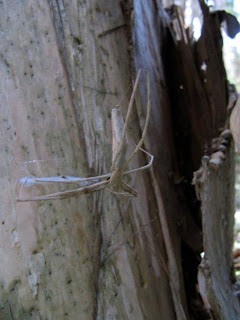Of course, the reality is nothing like this.
One of the biggest mistakes that Brits like myself are likely to make before coming down under is to underestimate just how big Australia is. The country has a land area of 7.69 million square kilometres, not far off the 9.83 million square kilometres that is the land area of the USA. In comparison the UK is a piddling 0.24 million square kilometres. A quick bit of maths tells you that the UK will fit into Australia more than 30 times.
So Australia is a BIG place. And so although there are some dangerous animals, they don't all live in the same place. You're not gonna get eaten by a salty, and bitten by a tiger snake and a redback all in the same day.
Here are some of Australia's usual suspects:
CROCODILES
 |
| Saltwater crocodile (human for scale!) |
JELLYFISH
Box jellyfish, or to be precise, Chironex fleckeri, are not too nice either. There are actually a whole shedload of jellyfish that come under the term 'box jellyfish'. They have a bit more of a nervous system than most other jellyfish, they have eyes not dissimilar to humans (except they have 24 of them), and it is thought can even show simple learning. C. fleckeri do have an extremely painful sting, that can kill in a matter of minutes, but there are relatively few documented cases of deaths in Australia - 64 since 1883. Being oceanic, they're not restricted to Australia, you're also likely to bump into one of these guys in much of South East Asia, including Thailand, Vietnam, Singapore and Indonesia.
SNAKES
Here's a picture I took of an inland taipan in The Australian Museum. This is the most venomous snake in the world (although this particular one isn't because it's dead). We've also seen live ones in zoos, but despite enthusiastic (although careful) looking we are yet to see a live wild snake in Australia. We've seen a ton of lizards, and even a green turtle, but not one snake. If we were to see one, it would most likely be a brown snake, which do have a nasty bite if disturbed, it would definitely not be one of these because we would have to be in the middle of the bloody desert! Hence the 'inland' bit of their name - they don't live where most of the people do.
SHARKS
This is a picture of a grey nurse shark, a species native to Australia, this particular one lives in Sydney Aquarium. There are sharks in the water in many places in Australia. There are often shark nets on beaches to protect bathers so you do need to be careful. Having said that, on one trip to Manly in Sydney there was a 'Warning! A shark has been spotted in the water!' message playing on repeat that all of the surfers and bathers were completely ignoring. Again, it depends where you are - some bits of Western Australia are considered particularly dangerous and there were 14 attacks and 2 fatalities in Australia last year. What is clear from those sorts of stats is that although sharks can be dangerous, if we are sensible with where and when we use the water, there is very little chance of being attacked. Species like the grey nurse are also, like many shark species, endangered, with millions of sharks killed each year, often 'finned' for shark fin soup. Sharks certainly have more to fear from us than the other way round.
SPIDERS
So on to my favourites, the spiders. There are lots of cool spiders to be found in Australia, here are a few:
 |
| St Andrew's cross spider in Centennial Park, Sydney |
 |
| Orge-faced spider, with a net of silk |
 |
| Huntsman spider - big, fast and harmless |
All of these spiders are entirely harmless, although some, like the huntsman, are fast enough to really freak you out if you're not expecting them. We've also been looking for spiders for the best part of four months now and these are the weirdest that we have found. No red-backs, no Sydney funnel webs, not even a golden orb web (although we did get to see a live one at the Melbourne Museum).
So Aussie spiders, like most other feared Aussie animals are there if you go looking for them, but you have to look quite hard. We have been really lucky however, because we have got to meet a huge number of unusual wild Australian animals: kangaroos, koalas, echidnas, wallabies, possums, galahs, king parrots, rosellas, lorikeets, green turtles, ibises, cockatoos and even a budgerigar.
I'll be putting up a whole photo diary of our full animal encounters when we come to the end of our time in Australia. Hopefully by then it might include one or two of those more dangerous critters that Australia is so famous for. And I'm sure I will survive to tell the tale.









